Vue2-VueX
1.vuex介绍
目标
- 什么是vuex
- 为什么学习vuex
通信方案

| 组件关系 | 数据通信 |
|---|---|
| 父子关系 | 父传子:props ; 子传父:$emit |
| 非父子关系 | vuex (一种组件通信方案) |
vuex是什么
Vuex 是一个专为 Vue.js 应用程序开发的状态管理模式。它采用集中式存储管理数据,以相应的规则保证状态以一种可预测的方式发生变化
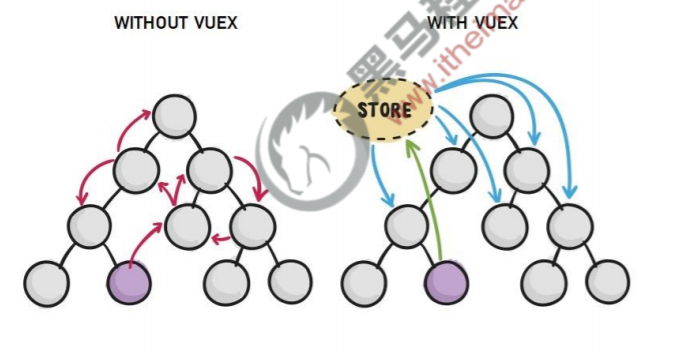
vuex为何学
程序页面多, 数据变量多
- 不同组件数据保持同步
- 数据的修改都是可追踪
一个户外商店有两名员工,张三和李四
一天的早上,他们分别对帐篷的数量做了一次盘点,发现一共有三个帐篷
张三卖出去俩个,他以为库存里还有一个
李四卖出去一个,他以为库存里还有两个
而事实上是,库存现在已经为零
如果他们再接受客户的预订,就会出现库存不足的情况
张三和李四因为没有保持库存的数量的同步导致了尴尬,这个就是所谓的
数据保持同步店长需要知道, 谁卖出了多少个帐篷,这个行为我们称之为
数据修改是可追踪的
图示:
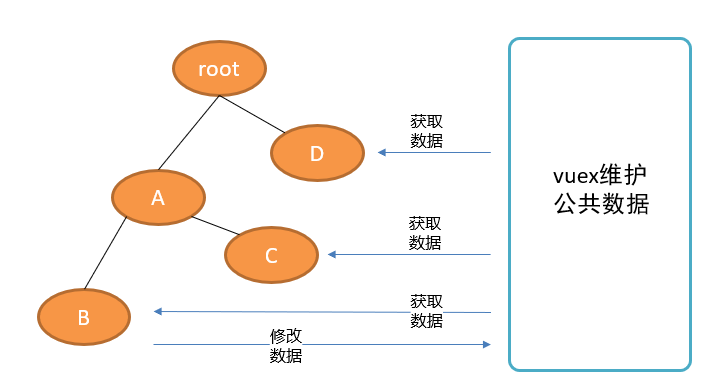
vuex中存什么
多个组件共享状态,才存储在vuex中
某个组件中的私有数据,依旧存储在data中
例如:
登陆的用户名需要在首页, 个人中心, 结算页面使用, 用户名存在vuex中
文章详情数据, 只有在文章详情页查看, 在自身data中声明
小结
- 什么是vuex
- vuex是Vue官方推荐的集中式状态管理机制
- 为何学vuex
- 数据同步, 集中管理
- vuex中存什么
- 多个组件共享的值
2.vuex学习内容
目标
- 知道vuex要学习什么
核心概念
安装(固定)
配置项(固定)
配置项 含义 注意 state 单一状态树 类似data mutations 数据管家(同步) 唯一修改state地方 actions 异步请求 要改state需要提交给mutations getters vuex计算属性 类似computed modules 模块拆分
图示关系
单一定义store对象, 里面5个配置项, 在任意组件可以使用

小结
- vuex五个核心概念是?
- state / mutations / actions / getters / modules
3.vuex例子准备
目标
- 创建项目, 为学习准备
需求1: App.vue(作为根组件)
需求2: 子组件Add和子组件Sub, 嵌入在App.vue里
需求3: 三个组件共享库存数据(保持同步)
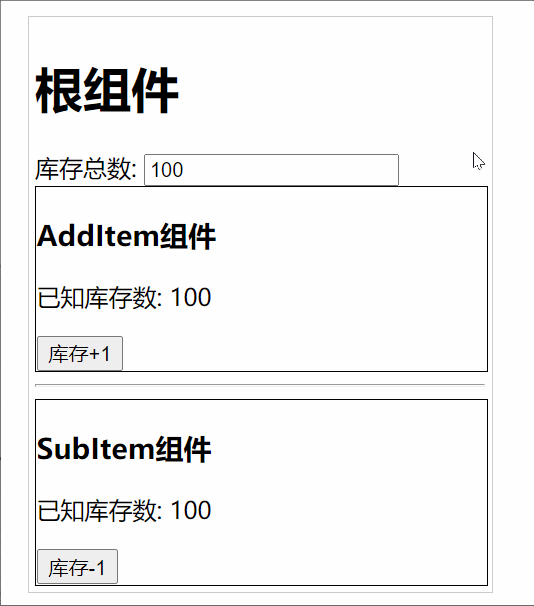
工程准备
初始化新的工程 vuex-demo
vue create vuex-demo清空欢迎界面
并设置如下三个组件, 目录如下:
|-components |---AddItem.vue |---SubItem.vue |-App.vue
App.vue
复制标签和样式, 引入AddItem和SubItem2个子组件显示
<template>
<div id="app">
<h1>根组件</h1>
<span>库存总数:</span>
<input type="text">
<div style="border:1px solid black; width: 300px;">
<AddItem></AddItem>
</div>
<hr>
<div style="border:1px solid black; width: 300px;">
<SubItem></SubItem>
</div>
</div>
</template>
<script>
import AddItem from '@/components/AddItem'
import SubItem from '@/components/SubItem'
export default {
components: {
AddItem,
SubItem
}
}
</script>
<style>
#app {
width: 300px;
margin: 20px auto;
border:1px solid #ccc;
padding:4px;
}
</style>
AddItem.vue
<template>
<div>
<h3>AddItem组件</h3>
<p>已知库存数: 0</p>
<button>库存+1</button>
</div>
</template>
<script>
export default {
}
</script>
SubItem.vue
<template>
<div>
<h3>SubItem组件</h3>
<p>已知库存数: 0</p>
<button>库存-1</button>
</div>
</template>
<script>
export default {
}
</script>
小结
- App下套用了AddItem和SubItem, 要在3个组件共享一个数据
4.vuex-store准备
目标
- 创建store仓库
- 注入到Vue项目中
store概念
每个 Vuex 应用的核心 store(仓库), 包含5个核心概念

vuex目录
和路由模块router/index.js - 类似, 维护项目目录的整洁,新建src/store/index.js文件
当然, 这个步骤并不是必需的
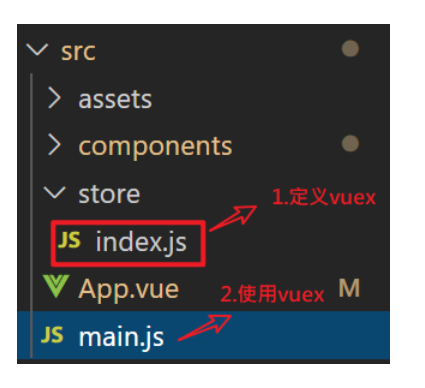
使用步骤
工程中 - 下载vuex
yarn add vuexstore/index.js - 创建定义导出store对象
// 目标: 创建store仓库对象 // 1. 下载vuex: 终端命令(yarn add vuex) // 2. 引入vuex import Vue from 'vue' import Vuex from 'vuex' // 3. 注册 Vue.use(Vuex) // 4. 实例化store对象 const store = new Vuex.Store({}) // 5. 导出store对象 export default storemain.js - 导入注入到Vue中
import Vue from 'vue' import App from './App.vue' import store from '@/store' // 导入store对象 Vue.config.productionTip = false new Vue({ // 6. 注入到Vue实例中(确保组件this.$store使用) // this.$store = store store, render: h => h(App), }).$mount('#app')
请再次回忆一下vue-router的用法,是不是很像?
小结
vuex的核心是什么?
- store对象(包含5个核心属性)
如何创建store对象?
- 工程下载vuex模块
- store/index.js
- 引入注册
- 生成store对象导出
- main.js - 导入注入
5.vuex-state数据源
目标
- 定义state
- 直接使用state
- 辅助函数mapState
state是唯一的公共数据源,统一存储
定义state
在store/index.js定义state
语法:
/*
const store = new Vuex.Store({
state: {
变量名: 初始值
}
})
*/
具体代码:
const store = new Vuex.Store({
state: {
count: 100 // 库存
}
})
使用state2种方式
方式1: 组件内 - 直接使用
语法:
this.$store.state.变量名方式2: 组件内 - 映射使用 (推荐)
语法:
// 1. 拿到mapState辅助函数 import { mapState } from 'vuex' export default { computed: { // 2. 把state里变量映射到计算属性中 ...mapState(['state里的变量名']) } }
AddItem直接用
<template>
<div>
<h3>AddItem组件</h3>
<p>已知库存数: {{ $store.state.count }}</p>
<button>库存+1</button>
</div>
</template>
App.vue直接用
计算属性count, 和输入框的v-model双向绑定
<input type="text" v-model="count">
<script>
export default {
computed: {
count: {
set(){},
get(){
return this.$store.state.count
}
}
}
}
</script>
SubItem映射用
<template>
<div>
<h3>SubItem组件</h3>
<p>已知库存数: {{ count }}</p>
<button>库存-1</button>
</div>
</template>
<script>
// 需求1: 映射state到计算属性
// 1. 拿到辅助函数 mapState
// 2. 在computed内, ...mapState(['state变量名'])
// 3. 当计算属性使用
import { mapState } from 'vuex'
// let r = mapState(['count']) // 提取store里的state叫count的变量
// console.log(r); // 返回值: {count: 函数体(return state里count的值)}
export default {
computed: {
// 映射count, 得到对象展开, 合并到计算属性中
...mapState(['count'])
},
}
</script>
整个过程的示意图如下
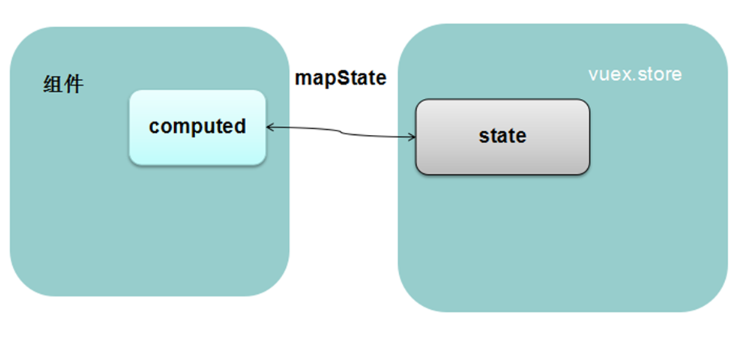
注意
state是响应式的, 只要state值变化, 页面上使用的地方会自动更新同步
小结
state作用?
定义全局状态数据源
state如何定义?
在store内, state: {变量名: 初始值}
state的值如何用到具体vue组件内?
- 直接使用 this.$store.state.变量名
- 映射使用 …mapState([‘state的变量名’])
6.vuex-mutations定义-同步修改
目标
- 定义mutations
定义mutations
mutations类似数据管家, 操作state里的数据
在store/index.js定义mutations
语法:
/*
const store = new Vuex.Store({
mutations: {
函数名 (state, 可选值) {
// 同步修改state值代码
}
}
})
*/
具体代码
const store = new Vuex.Store({
state: {
count: 100 // 库存
},
mutations: {
addCount (state, value) { // 负责增加库存的管家
state.count += value
},
subCount (state, value) { // 负责减少库存的管家
state.count -= value
},
setCount (state, value) { // 负责直接修改库存的管家
state.count = value;
}
}
})
注意
- mutations是唯一能修改state的地方, 确保调试工具可以追踪变化
- mutations函数内, 只能写同步代码, 调试工具可追踪变化过程
- 因为调试工具要立刻产生一次记录, 所以必须是同步的
小结
mutations里函数作用?
- 负责修改state里的数据
mutations只能写什么样的代码?
- 同步流程的代码
7.vuex-mutations使用
目标
- 使用mutations2种方式
- mutations注意事项
使用mutations的2种方式
方式1: 组件内 - 直接使用
语法:
this.$store.commit("mutations里的函数名", 具体值)方式2: 组件内 - 映射使用
语法:
// 1. 拿到mapMutations辅助函数 import { mapMutations } from 'vuex' export default { methods: { // 2. 把mutations里方法映射到原地 ...mapMutations(['mutations里的函数名']) } }
AddItem直接用
- 点击事件绑定
- 提交mutations传入值
<button @click="addFn">库存+1</button>
<script>
export default {
methods: {
addFn(){
this.$store.commit('addCount', 1)
}
}
}
</script>
App.vue直接用
- 触发计算属性的set方法
- 提交mutations传入值
<span>库存总数: </span>
<input type="text" v-model="count">
<script>
export default {
computed: {
count: {
set(val){
this.$store.commit('setCount', val) // 把表单值提交给store下的mutations
},
get(){
return this.$store.state.count
}
}
}
}
</script>
SubItem映射用
- 点击事件
- 映射mutations的方法
- 调用mutations方法传值
<button @click="subFn">库存-1</button>
<script>
// 需求2: 映射mutations到方法里
// 1. 拿到辅助函数 mapMutations
// 2. 在methods内, ...mapMutations(['mutations函数名'])
// 3. 当普通方法使用
import { mapMutations } from 'vuex'
export default {
methods: {
...mapMutations(['subCount']),
subFn(){
this.subCount(1)
}
}
}
</script>
注意
mutations函数上, 只能接收一个参数值, 如果传对个, 请传一个对象
小结
mutations有哪2种使用方式?
直接使用 this.$store.commit()
映射使用 mapMutations把方法映射到组件内直接调用
state, mutations, 视图组件, 3个关系是什么?
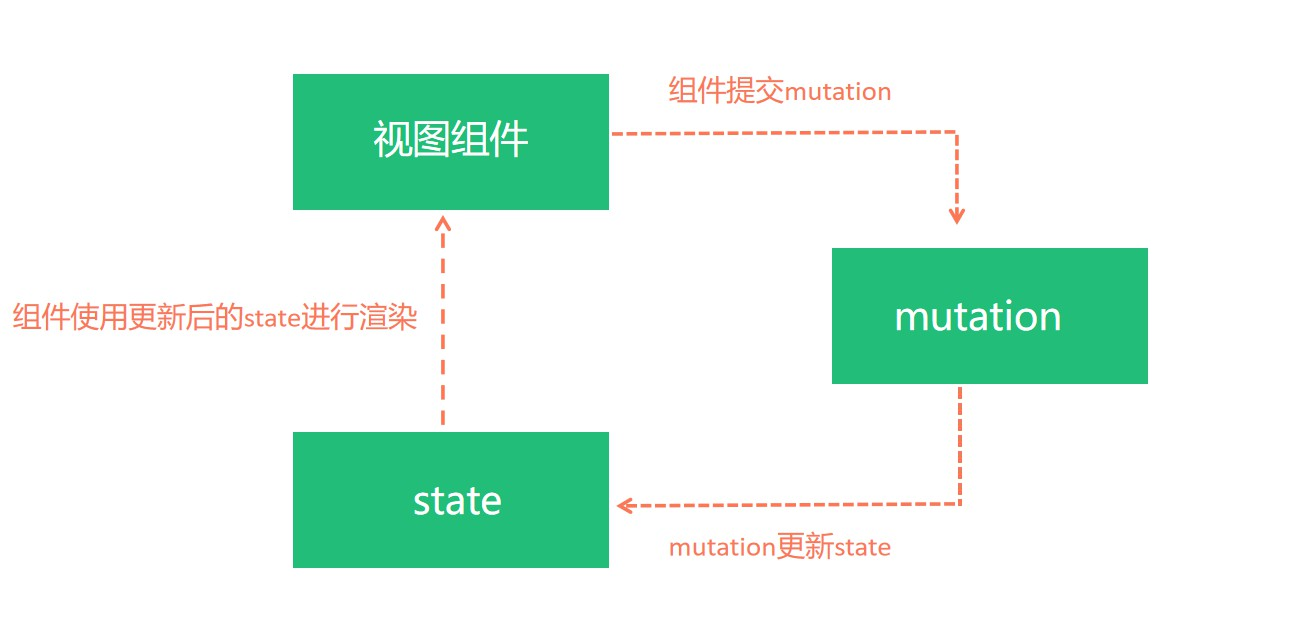
8.vuex-actions定义-异步修改
目标
- 定义actions
定义actions
在store/index.js定义actions
语法:
/*
const store = new Vuex.Store({
actions: {
函数名 (store, 可选值) {
// 异步代码, 把结果commit给mutations给state赋值
}
}
})
*/
具体代码:
const store = new Vuex.Store({
// ...省略state和mutations此处
actions: {
asyncAddCount(store, num){
setTimeout(() => { // 1秒后, 异步提交给add的mutations
store.commit('addCount', num)
}, 1000)
},
asyncSubCount(store, num) {
setTimeout(() => { // 1秒后, 异步提交给sub的mutations
store.commit('subCount', num)
}, 1000)
}
}
})
小结
actions和mutations区别?
mutations里同步修改state
actions里放入异步操作
actions是否能操作state?
不建议, 要commit给mutations(为调试工具可追踪)
actions和mutations里函数, 第一个形参分别是什么?
mutations的是state
actions的是store
9.vuex-actions使用
目标
- 使用actions
使用actions的2种方式
方式1: 组件内 - 直接使用
语法:
this.$store.dispatch('actions函数名', 具体值)方式2: 组件内 - 映射使用
语法:
// 1. 拿到mapActions辅助函数 import { mapActions } from 'vuex' export default { methods: { // 2. 把actions里方法映射到原地 ...mapActions(['actions里的函数名']) } }
AddItem直接用
- 点击事件
- dispatch触发action
<button @click="asyncAddFn">延迟1秒, 库存+5</button>
<script>
export default {
methods: {
asyncAddFn(){
this.$store.dispatch('asyncAddCount', 5)
}
}
}
</script>
SubItem映射用
- 点击事件
- 映射actions的方法
- 调用actions的方法传值
<button @click="asyncSubFn">延迟1秒, 库存-5</button>
<script>
// 需求3: 映射actions到方法里
// 1. 拿到辅助函数 mapActions
// 2. 在methods内, ...mapActions(['actions函数名'])
// 3. 当普通方法使用
import { mapActions } from 'vuex'
export default {
methods: {
...mapActions(['asyncSubCount']),
asyncSubFn(){
this.asyncSubCount(5)
}
}
}
</script>
小结
actions使用方式?
方式1: this.$store.dispatch(‘actions方法名字’, 值)
方式2: …mapActions([‘actions里的方法名’]) 映射到原地使用
视图组件, state, mutations, actions的关系是?
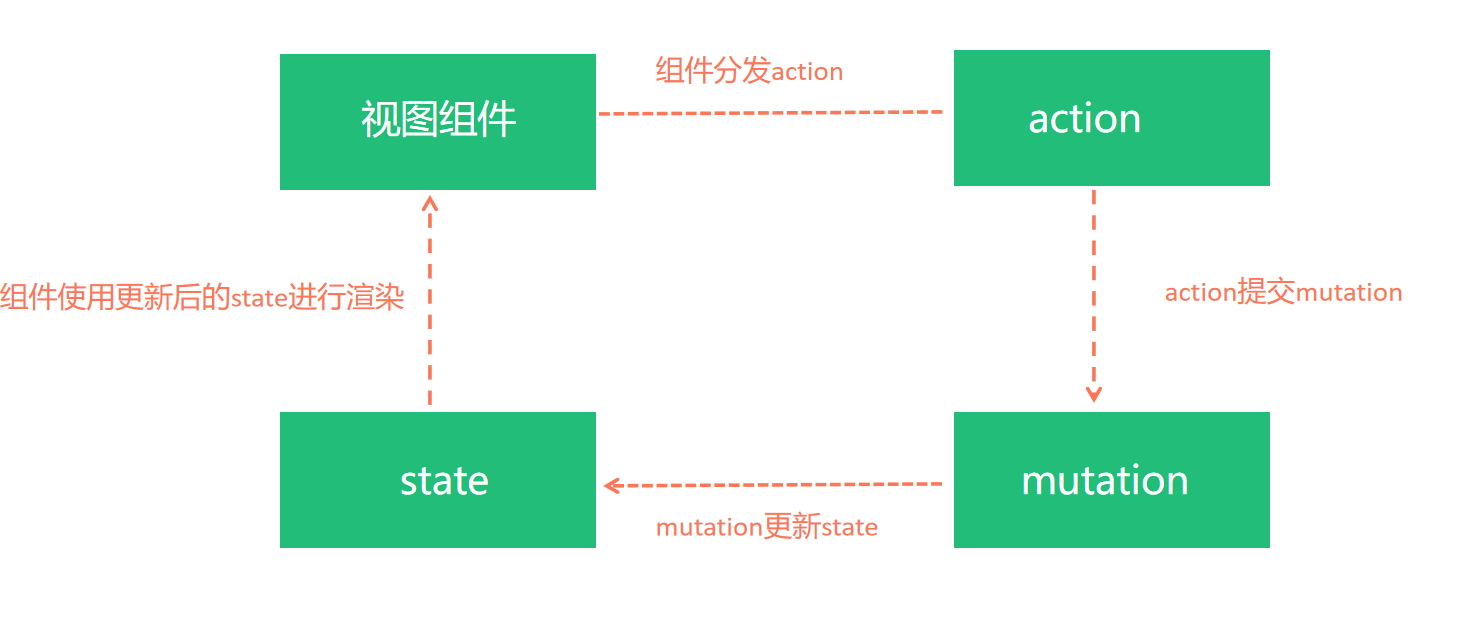
10.vuex-重构购物车-准备Store
目标
- 在现有项目如何集成vuex
store准备
- 复制预习资料<shopcar-模板>到自己今天文件夹下
- 下载vuex
- store/index.js创建导出store对象
- main.js把store引入, 然后注入到Vue实例
小结
现有项目如何集成vuex
下载vuex
创建store对象并注入到Vue实例中
11.vuex-重构购物车-配置项(上午结束)
目标
- 准备state和mutations还有actions
配置项准备
- 定义state - 保存商品列表数组
state: {
goodsList: [] // 列表
}
- 定义mutations - 给state里变量赋值
mutations: {
setGoodsList(state, newList) {
state.goodsList = newList
}
}
- 定义actions - 异步请求数据提交给mutations
actions: {
async asyncGetGoodsList(store) {
const url = `https://www.escook.cn/api/cart`
// 发送异步请求
const res = await axios({ url: url });
store.commit('setGoodsList', res.data.list) // 提交mutation修改state中的数据
}
}
App.vue使用vuex
- 把vuex商品数组映射回来使用
- 网络请求调用actions方法
<script>
import { mapState, mapActions } from 'vuex'
export default {
computed: {
...mapState({list: 'goodsList'}) // 自定义原地属性名list, 映射vuex里的goodsList变量值
},
created(){
this.asyncGetGoodsList()
},
methods: {
...mapActions(['asyncGetGoodsList']),
allFn(bool){
this.list.forEach(obj => obj.goods_state = bool)
}
}
}
</script>
小结
mapState可以改变映射到原地的计算属性名吗?
可以的, 格式…mapState({‘‘计算属性名’, ‘state里要映射的变量名’})
12.vuex-getters定义-计算属性
目标
- getters概念
- 定义getters
getters概念
vuex身上的全局状态-计算属性, 类似于computed
getters 依赖于 state中原始数据的变化,并返回计算后的新数据
定义getters
在store/index.js定义getters
语法:
/*
const store = new Vuex.Store({
getters: {
计算属性名 (state) {
return 值给计算属性
}
}
})
*/
具体代码
const store = new Vuex.Store({
// ...省略其他
getters: {
allCount(state) {
return state.goodsList.reduce((sum, obj) => {
if (obj.goods_state === true) { // 选中商品才累加数量
sum += obj.goods_count;
}
return sum;
}, 0)
},
allPrice(state) {
return state.goodsList.reduce((sum, obj) => {
if (obj.goods_state) {
sum += obj.goods_count * obj.goods_price
}
return sum;
}, 0)
}
}
})
小结
getters有什么用?
vuex里的计算属性, 属于全局计算属性, 类似computed
13.vuex-getters使用
目标
- 组件内使用getters
使用getters的2种方式
方式1: 组件内 - 直接使用
语法:
this.$store.getters.计算属性名方式2: 组件内 - 映射使用
语法:
// 1. 拿到mapGetters辅助函数 import { mapGetters } from 'vuex' export default { computed: { // 2. 把getters里属性映射到原地 ...mapGetters(['getters里的计算属性名']) } }
MyFooter.vue里使用
- 使用2种方式给计算属性值
<script>
import { mapGetters } from 'vuex'
export default {
computed: {
allCount(){
return this.$store.getters.allCount;
},
...mapGetters(['allPrice'])
}
}
</script>
小结
getters如何使用?
方式1: this.$store.getters.计算属性名
方式2: …mapGetters([‘getters里计算属性名’])
14.vuex-modules定义-分模块
目标
- 为何要分模块
- modules定义
为何分模块
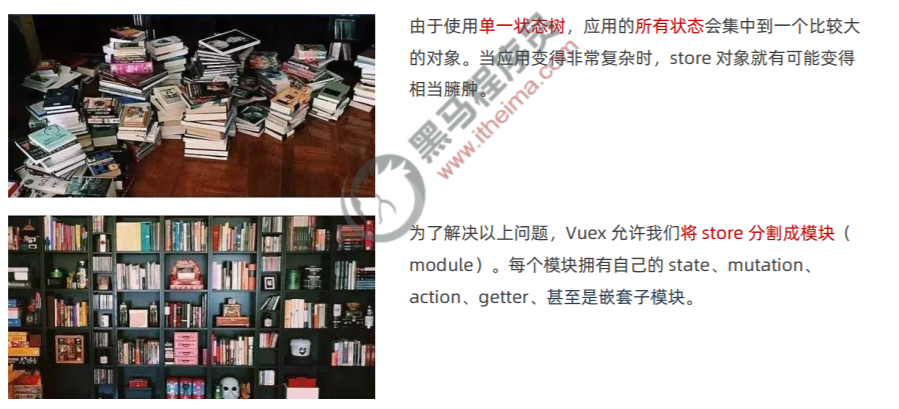
代码上的对比
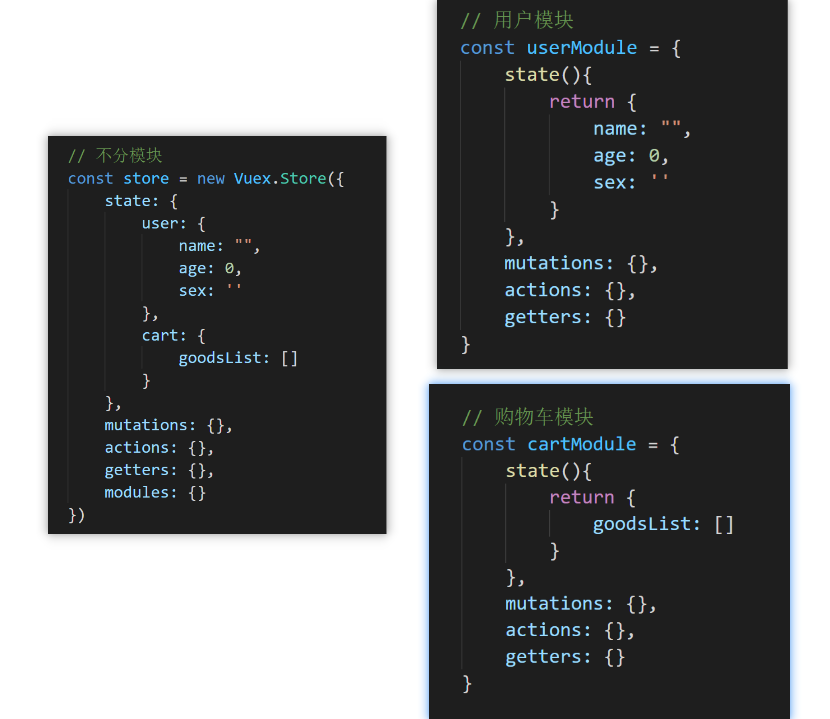
创建modules模块对象
- 新建store/modules/user.js
- 新建store/modules/cart.js
语法: 对象里包含5个核心概念, 只有state变成函数形式
user.js - 用户模块对象
// 用户模块对象
const userModule = {
state(){
return {
name: "",
age: 0,
sex: ''
}
},
mutations: {},
actions: {},
getters: {}
}
export default userModule
cart.js - 购物车模块对象
// 购物车模块对象
import axios from 'axios'
const cartModule = {
state() {
return {
goodsList: []
}
},
mutations: {
setGoodsList(state, newList) {
state.goodsList = newList
}
},
actions: {
async asyncGetGoodsList(store) {
const url = `https://www.escook.cn/api/cart`
// 发送异步请求
const res = await axios({ url: url });
store.commit('setGoodsList', res.data.list) // 提交mutation修改state中的数据
}
},
getters: {
allCount(state) {
return state.goodsList.reduce((sum, obj) => {
if (obj.goods_state === true) { // 选中商品才累加数量
sum += obj.goods_count;
}
return sum;
}, 0)
},
allPrice(state) {
return state.goodsList.reduce((sum, obj) => {
if (obj.goods_state) {
sum += obj.goods_count * obj.goods_price
}
return sum;
}, 0)
}
}
}
export default cartModule
定义modules
语法:
modules: {
模块名: 模块对象
}
- 把2个模块对象, 引回到store里注册
import Vue from 'vue'
import Vuex from 'vuex'
import cartModule from './modules/cart'
import userModule from './modules/user'
Vue.use(Vuex)
const store = new Vuex.Store({
modules: {
user: userModule,
cart: cartModule
}
})
export default store
小结
为什么分模块?
集中式管理项目过大, 变量过多, 会导致state臃肿, 难以维护
如何分模块?
定义模块对象, state变成函数返回对象形式, 每个模块都有state/mutations/actions/getters/modules
根store如何注册?
modules里 { 模块名: 模块对象 }
15.分模块-影响state取值方式
目的
- 只要分模块, state取值方式改变, 其他暂时不变
state使用方式修改
方式1: 组件内 - 直接使用
原语法:
this.$store.state.变量名分模块后语法:
this.$store.state.模块名.变量名方式2: 组件内 - 映射使用
原语法:
...mapState(['state里变量名']) ...mapState({'变量名': "state里变量名"}) // 给映射过来的state起别的名字分模块后语法:
...mapState({ '变量名': state => state.模块名.变量名 })
App.vue-修改
computed: {
// ...mapState({list: 'goodsList'}) // 本地属性名list, 映射vuex里的goodsList变量值
// 方式1: 直接用
// list(){ // 这个list就是组件内普通的计算属性名
// return this.$store.state.cart.goodsList
// }.
// 方式2: 映射方式改变
...mapState({'list': state => state.cart.goodsList})
},
小结
分模块对什么有影响?
对state的取值方式有影响, 对其他暂无影响
state如何取值?
在组件使用的时候, 要state.模块名.变量名
16.分模块-命名空间
目标
- 防止多个模块之间, mutations/actions/getters的名字冲突
开启命名空间
在模块对象内设置namespaced: true
const moduleShopCar = {
namespaced: true,
state () {},
mutations: {},
actions: {},
getters: {},
modules: {}
}
state使用方式修改
直接使用无变化: this.$store.state.模块名.变量名
辅助函数需要遵守格式
...mapState("模块名", ['state变量名'])
mutations使用方式修改
方式1: 组件内 - 直接使用
原语法:
this.$store.commit("mutations里的函数名", 具体值)开命名空间后语法:
this.$store.commit("模块名/mutations里的函数名", 具体值)
方式2: 组件内 - 映射使用
原语法:
...mapMutations(['mutations里方法名'])开命名空间后语法:
...mapMutations("模块名", ['mutations里方法名'])
actions使用方式修改
方式1: 组件内 - 直接使用
原语法:
this.$store.dispatch("actions里的函数名", 具体值)开命名空间后语法:
this.$store.dispatch("模块名/actions里的函数名", 具体值)
方式2: 组件内 - 映射使用
原语法:
...mapActions(['actions里方法名'])开命名空间后语法:
...mapActions("模块名", ['actions里方法名'])
getters使用方式修改
方式1: 组件内 - 直接使用
原语法:
this.$store.getters.计算属性名开命名空间后语法:
this.$store.getters['模块名/计算属性名']
方式2: 组件内 - 映射使用
原语法:
...mapGetters(['getters里计算属性名'])开命名空间后语法:
...mapGetters("模块名", ['getters里计算属性名'])
小结
- state和mutations, 在根store和开启命名空间里的区别?
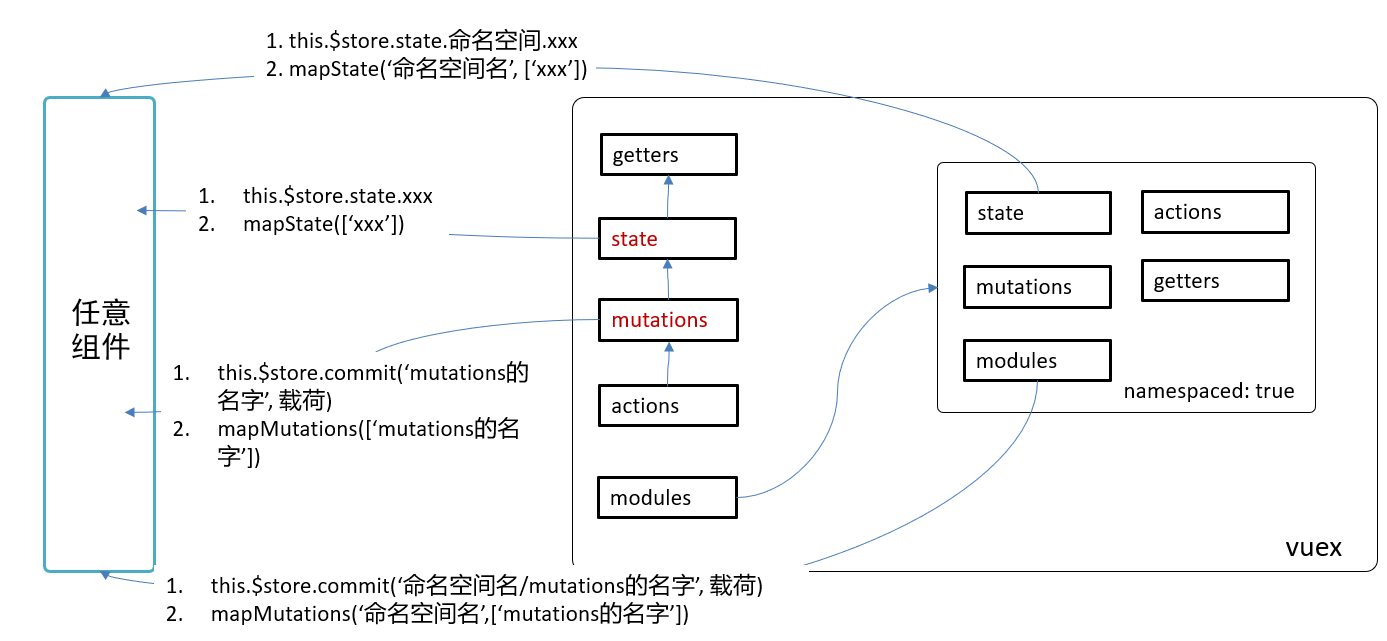
- 整个vuex的体系是?
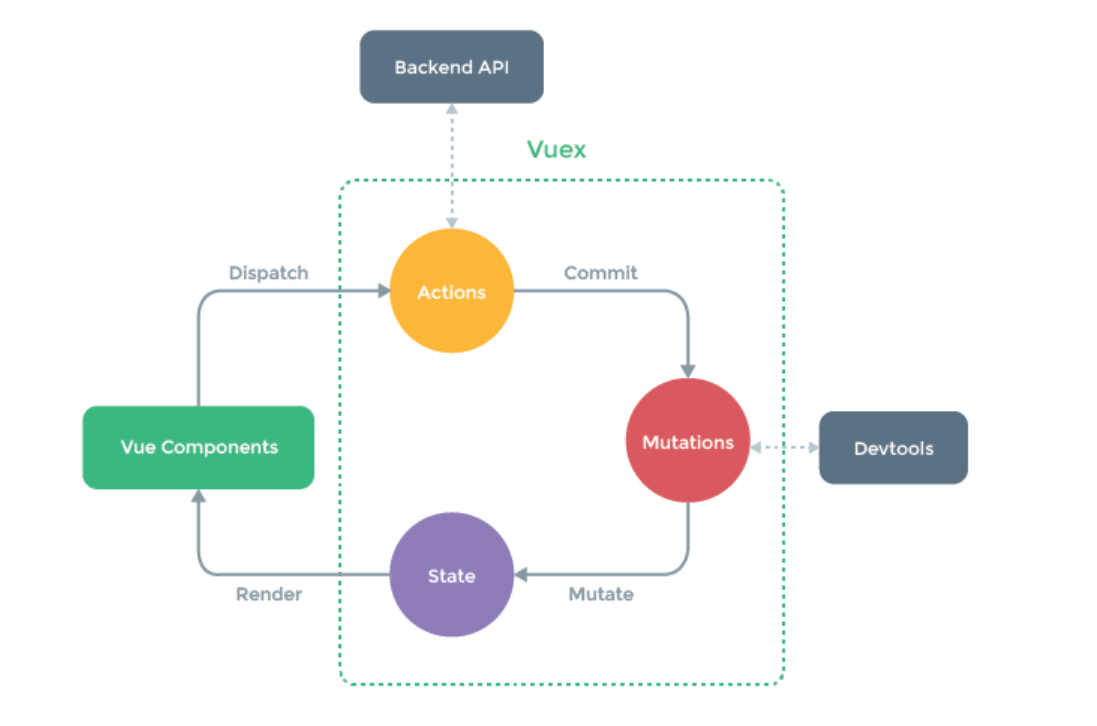
扩展: 使用Devtools调试vuex数据
优秀的调试工具可以使我们写程序事半功倍,最后我们再学习一下如果使用dev-tools来调试vuex中的数据,这也是数据可预测特性里不可缺少的一环
目标
- 掌握dev-tools调试vuex
- 理解什么是数据状态是可追踪的
Vue3-Vuex
Vuex介绍
Vuex是什么
Vuex 是一个专为 Vue.js 应用程序开发的状态管理模式。它采用集中式存储管理数据,以相应的规则保证状态以一种可预测的方式发生变化
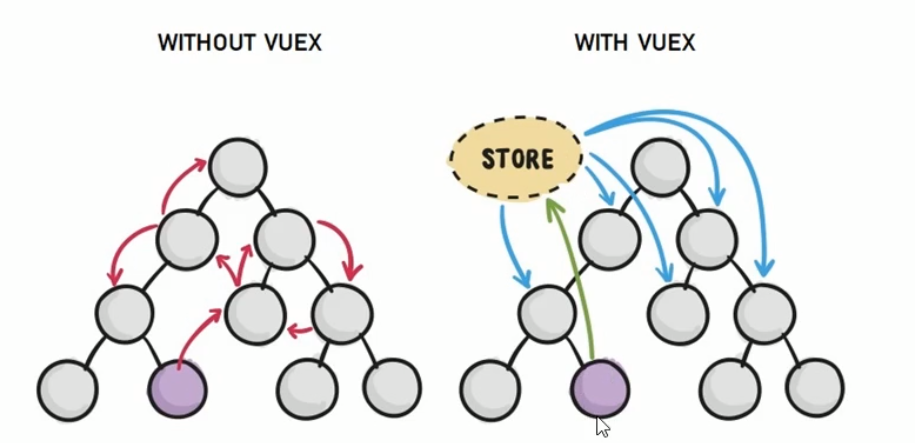
优点:
- 能够在Vuex中集中管理共享的数居,易于开发和后期维护
- 能够高效地实现组件之间的数据共享,提高开发效率
- 存储在vuex中的数据都是响应式的,能够实时保持数据与页面的同步
vuex为何学
程序页面多, 数据变量多
- 不同组件数据保持同步
- 数据的修改都是可追踪
一个户外商店有两名员工,张三和李四
一天的早上,他们分别对帐篷的数量做了一次盘点,发现一共有三个帐篷
张三卖出去俩个,他以为库存里还有一个
李四卖出去一个,他以为库存里还有两个
而事实上是,库存现在已经为零
如果他们再接受客户的预订,就会出现库存不足的情况
张三和李四因为没有保持库存的数量的同步导致了尴尬,这个就是所谓的
数据保持同步店长需要知道, 谁卖出了多少个帐篷,这个行为我们称之为
数据修改是可追踪的
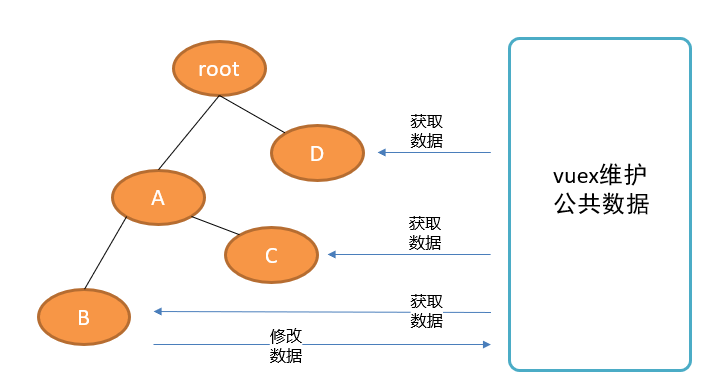
vuex中存什么
多个组件共享状态,才存储在vuex中
某个组件中的私有数据,依旧存储在data中
例如:
- 登陆的用户名需要在首页, 个人中心, 结算页面使用, 用户名存在vuex中
- 文章详情数据, 只有在文章详情页查看, 在自身data中声明
基本使用
- 安装 vuex 依赖包
npm install vuex --save
- 导入
import Vuex from 'vuex'
app.use(Vuex)
- 创建 store 对象
const store = new Vuex.Store({
// state 中存放的就是全局共享的数据
state: { count: 0 }
})
- 将 store 对象挂载到 vue 实例中
new Vue({
el: '#app',
render: h => h(App),
router
// 将创建的共享数据对象挂载到 Vue 实例中
// 所有的组件, 就可以直接从 store 中获取全局的数据
}).$mount('#app')
// Vue3
import { createApp } from 'vue'
import { createStore } from 'vuex'
// 创建一个新的 store 实例
const store = createStore({
state () {
return {
count: 0
}
},
mutations: {
increment (state) {
state.count++
}
}
})
const app = createApp({ /* 根组件 */ })
// 将 store 实例作为插件安装
app.use(store)
state
state是唯一的公共数据源,统一存储
// store/index.js
import { createStore } from 'vuex'
// 配置 Vuex
const store = createStore({
state() {
return {
text: '我的博客 www.misterma.com',
num: 12
}
},
mutations: {
changeText(state) {
state.text = 'github https://github.com/changbin1997';
},
changeNum(state) {
state.num ++;
}
}
});
export default store
使用
- 方式1: 组件内 - 直接使用
this.$store.state.变量名
import {useStore} from 'vuex';
const store = useStore();
console.log(store.state.变量名);
- 方式2: 组件内 - 映射使用 (推荐)
import {computed} from 'vue';
const text = computed(() => store.state.text);
const num = computed(() => store.state.num);
state是响应式的, 只要state值变化, 页面上使用的地方会自动更新同步
mutations
Vuex Mutations 则是用于修改状态的函数。在 Vuex 中,状态是通过 store 对象进行管理的,而 Mutations 则是通过提交(commit)来执行的。每个 Mutation 都是一个纯函数,它接收 state 对象作为第一个参数,并且可以接收额外的参数作为载荷(payload)。Mutation 函数用于同步地改变状态,它们在开发过程中可以帮助我们跟踪状态的变化。
在 Vue 3 中,Mutations 并不是唯一能修改 state 的地方。实际上,在 Vue 3 中,可以通过使用 Mutations、Actions 或直接操作 state 来修改状态。这是与 Vue 2 中的 Vuex 不同的地方。
在 Vue 3 中,可以使用 Mutations 来同步地改变状态,Actions 用于处理异步操作并提交 Mutations,而直接操作 state 则是为了简单的状态变化。这种方式使得状态管理更加灵活,并且能够更好地处理异步操作。
因此,在 Vue 3 中,Mutations 并不是唯一能修改 state 的地方,而是状态管理中的一部分,开发者可以根据具体情况选择合适的方式来修改状态。
以下是一个 mutations 与 store 结合的例子
<!-- App.vue -->
<template>
<div>
<!--输出 store 配置的 text 和 num-->
<p>{{ store.state.text }}</p>
<p>{{ store.state.num }}</p>
<button type="button" @click="buttonClick">更改 text 和 num</button>
</div>
</template>
<script setup>
import {useStore} from 'vuex';
const store = useStore();
function buttonClick() {
// 更改 text 和 num
store.commit('changeText');
store.commit('changeNum');
}
</script>
// store/index.js
import { createRouter, createWebHistory } from 'vue-router'
const routes = [
{
path: '/login',
name: 'login',
component: () => import('@/components/login.vue')
},
{
path: '/main',
name: 'main',
component: () => import('@/components/main.vue')
}
]
const router = createRouter({
history: createWebHistory(),
routes
})
export default router
actions
在 Vue 3 中,使用 Vuex 的 Actions 是一种处理异步操作并提交 Mutations 的方式。Actions 允许您在应用程序中执行异步操作,例如从服务器获取数据,然后再提交 Mutations 来修改状态。以下是在 Vue 3 中使用 Vuex Actions 的基本方法:
const store = new Vuex.Store({
// ...省略state和mutations此处
actions: {
asyncAddCount(store, num){
setTimeout(() => { // 1秒后, 异步提交给add的mutations
store.commit('addCount', num)
}, 1000)
},
asyncSubCount(store, num) {
setTimeout(() => { // 1秒后, 异步提交给sub的mutations
store.commit('subCount', num)
}, 1000)
}
}
})
getters
Vuex Getters 是用于从 store 中获取状态的函数。Getters 允许您在 store 中计算状态或过滤数据,并且可以在组件中像计算属性一样使用。以下是在 Vue 3 中定义和使用 Vuex Getters 的基本方法:
const store = new Vuex.Store({
// ...省略其他
getters: {
allCount(state) {
return state.goodsList.reduce((sum, obj) => {
if (obj.goods_state === true) { // 选中商品才累加数量
sum += obj.goods_count;
}
return sum;
}, 0)
},
allPrice(state) {
return state.goodsList.reduce((sum, obj) => {
if (obj.goods_state) {
sum += obj.goods_count * obj.goods_price
}
return sum;
}, 0)
}
}
})
用getters的2种方式
方式1: 组件内 - 直接使用
语法:
this.$store.getters.计算属性名方式2: 组件内 - 映射使用
语法:
// 1. 拿到mapGetters辅助函数 import { mapGetters } from 'vuex' export default { computed: { // 2. 把getters里属性映射到原地 ...mapGetters(['getters里的计算属性名']) } }
MyFooter.vue里使用
- 使用2种方式给计算属性值
<script>
import { mapGetters } from 'vuex'
export default {
computed: {
allCount(){
return this.$store.getters.allCount;
},
...mapGetters(['allPrice'])
}
}
</script>